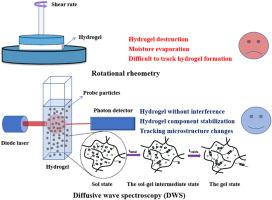Our official English website, www.x-mol.net, welcomes your
feedback! (Note: you will need to create a separate account there.)
Investigating the pH-Dependence of Gelation process in Chitosan-glutaraldehyde Hydrogels with Diffusing Wave Spectroscopy
Polymer ( IF 4.1 ) Pub Date : 2024-11-12 , DOI: 10.1016/j.polymer.2024.127827 Xiaoqiang Xue, Xuepei Miao, Jian Liu, Yi Ding, Yuheng Zhang, Yunkai Sun, Wenyan Huang, Qimin Jiang, Bibiao Jiang, Sridhar Komarneni
Polymer ( IF 4.1 ) Pub Date : 2024-11-12 , DOI: 10.1016/j.polymer.2024.127827 Xiaoqiang Xue, Xuepei Miao, Jian Liu, Yi Ding, Yuheng Zhang, Yunkai Sun, Wenyan Huang, Qimin Jiang, Bibiao Jiang, Sridhar Komarneni

|
The gel time of functional hydrogels is an essential property that dictates their utility in various applications. To accurately assess this parameter, the chitosan-glutaraldehyde hydrogels were characterized here using two complementary analytical tools, rotational rheometer, and diffusing wave spectrometer (DWS). Rotational rheometers are widely used to continuously monitor the macro-mechanical properties of hydrogels during the gelation process. By observing the modulus change curve, one can gain insights into the instantaneous changes occurring within the gel network. This method provides a direct measurement of the gel's mechanical strength; however, it involves applying external forces to the sample, which may introduce artifacts such as measurement lag and potential sample deformation or destruction. Results of this study indicated that the application of external force during rotary rheometer measurements disrupted the gelation process. In contrast, DWS detected alterations in the microstructure by measuring light diffusion, allowing to track microstructural changes post-crosslinking, and curing without the interference of external stress. Thus, DWS offers a non-invasive approach to studying gelation as it detected the Brownian motion of particles within the hydrogel by monitoring the diffraction of light, thereby providing undisturbed dynamic information about the gel's behavior. The DWS technique is particularly useful for tracking microstructural changes that occur during hydrogel crosslinking and curing, without altering the gel's native state. An additional advantage of DWS is its ability to investigate the pH effect on gelation. By measuring changes in gelation time as a function of pH, we could achieve precise control over the gelation process. This fine-tuning of gelation kinetics is crucial for applications that require rapid or delayed gelation, offering a level of precision that is difficult to match with traditional rheological methods.
中文翻译:

用扩散波光谱研究壳聚糖-戊二醛水凝胶中凝胶化过程的 pH 依赖性
功能性水凝胶的凝胶时间是决定其在各种应用中的效用的基本特性。为了准确评估该参数,这里使用两种互补的分析工具,旋转流变仪和扩散波光谱仪 (DWS) 对壳聚糖-戊二醛水凝胶进行了表征。旋转流变仪广泛用于在凝胶化过程中连续监测水凝胶的宏观机械性能。通过观察模量变化曲线,可以深入了解凝胶网络内发生的瞬时变化。该方法可直接测量凝胶的机械强度;但是,它涉及对样品施加外力,这可能会引入测量滞后和潜在的样品变形或破坏等伪影。这项研究的结果表明,在旋转流变仪测量过程中施加外力会破坏凝胶化过程。相比之下,DWS 通过测量光扩散来检测微观结构的变化,从而可以跟踪交联后的微观结构变化,并在不受外部应力干扰的情况下进行固化。因此,DWS 提供了一种研究凝胶化的非侵入性方法,因为它通过监测光的衍射来检测水凝胶内颗粒的布朗运动,从而提供有关凝胶行为的不受干扰的动态信息。DWS 技术对于跟踪水凝胶交联和固化过程中发生的微观结构变化特别有用,而不会改变凝胶的天然状态。DWS 的另一个优点是它能够研究 pH 值对凝胶化的影响。通过测量凝胶时间随 pH 值的变化,我们可以实现对凝胶化过程的精确控制。 这种凝胶动力学的微调对于需要快速或延迟凝胶化的应用至关重要,可提供传统流变学方法难以匹敌的精度水平。
更新日期:2024-11-13
中文翻译:

用扩散波光谱研究壳聚糖-戊二醛水凝胶中凝胶化过程的 pH 依赖性
功能性水凝胶的凝胶时间是决定其在各种应用中的效用的基本特性。为了准确评估该参数,这里使用两种互补的分析工具,旋转流变仪和扩散波光谱仪 (DWS) 对壳聚糖-戊二醛水凝胶进行了表征。旋转流变仪广泛用于在凝胶化过程中连续监测水凝胶的宏观机械性能。通过观察模量变化曲线,可以深入了解凝胶网络内发生的瞬时变化。该方法可直接测量凝胶的机械强度;但是,它涉及对样品施加外力,这可能会引入测量滞后和潜在的样品变形或破坏等伪影。这项研究的结果表明,在旋转流变仪测量过程中施加外力会破坏凝胶化过程。相比之下,DWS 通过测量光扩散来检测微观结构的变化,从而可以跟踪交联后的微观结构变化,并在不受外部应力干扰的情况下进行固化。因此,DWS 提供了一种研究凝胶化的非侵入性方法,因为它通过监测光的衍射来检测水凝胶内颗粒的布朗运动,从而提供有关凝胶行为的不受干扰的动态信息。DWS 技术对于跟踪水凝胶交联和固化过程中发生的微观结构变化特别有用,而不会改变凝胶的天然状态。DWS 的另一个优点是它能够研究 pH 值对凝胶化的影响。通过测量凝胶时间随 pH 值的变化,我们可以实现对凝胶化过程的精确控制。 这种凝胶动力学的微调对于需要快速或延迟凝胶化的应用至关重要,可提供传统流变学方法难以匹敌的精度水平。


















































 京公网安备 11010802027423号
京公网安备 11010802027423号